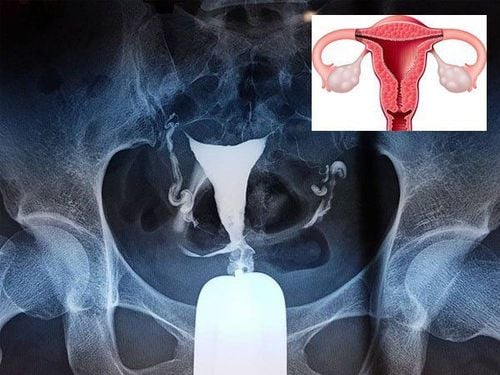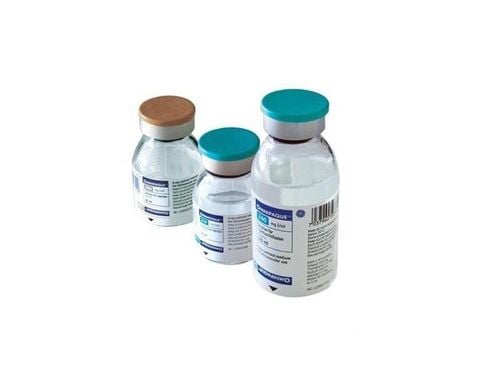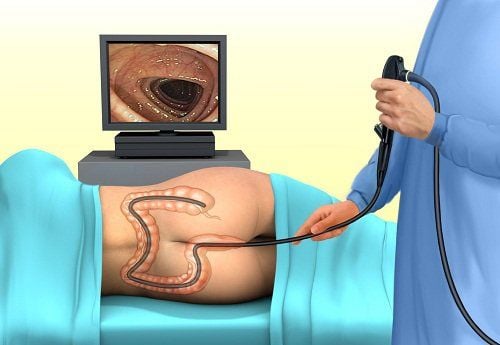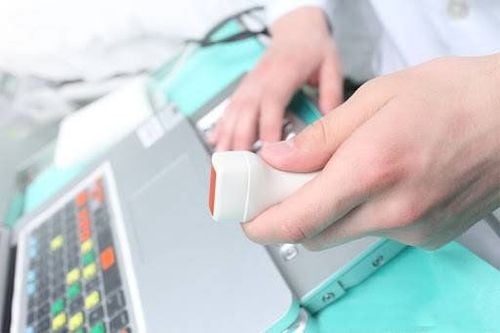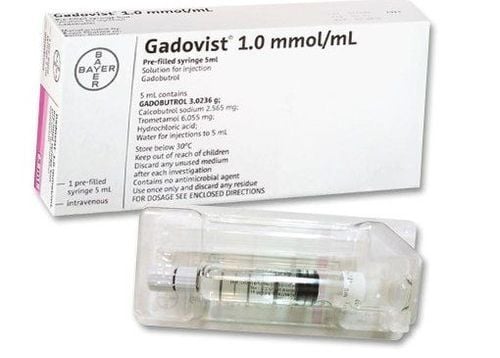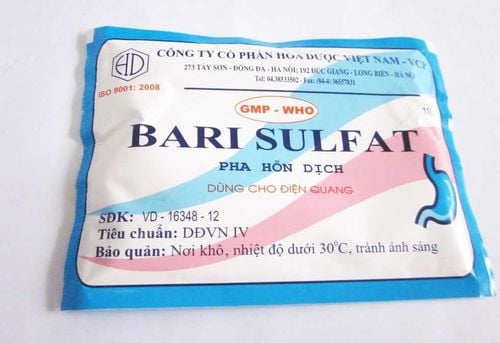This is an automatically translated article.
Xenetix 300mg 100ml or Xenetix 300 for short, this is a contrast agent containing iodine. Xenetix medicine 300mg is used to diagnose X-rays in some cases such as urography, cardiovascular, angiography, arthroscopy, uterus - fallopian tubes in women.
1. Uses of Xenetix 300
Xenetix 300 belongs to the group of drugs used in diagnosis, with the main ingredient being Iodine 30g/100ml (Iobitridol 65.81g/100mg). Iobitridol has contrasting properties, after entering the body through the intravenous route, it will be distributed into the circulatory system and the interstitial space. The half-life in humans is 1.8 hours and the mean systemic clearance is 93 mL/min.Xenetix 300mg drug is prepared in the form of an injection solution and is indicated in the diagnosis of X-rays in the following cases:
Intravenous urography CT scan Intravenous vasculature according to technical methods No. Angiography Angiography Cardiovascular X-ray Arthritis X-ray of the uterus and fallopian tubes
2. Usage and dosage of Xenetix 300
Xenetix medicine 300mg 100ml is administered by injection and conducted by medical staff. Depending on the imaging technique and the area of the body to be scanned, the patient's weight and kidney function, the dose will be different.
The recommended dose of Xenetix 300 by intravenous route is as follows:
Intravenous urography: The average dose for rapid intravenous injection is 1.2ml/kg body weight and slow vein is 1.6ml/kg weight. Minimum total volume is 50ml and maximum is 100ml. Brain CT scan: The average dose is 1.4ml/kg body weight. Minimum total volume of Xenetix 300 is 20ml and maximum is 100ml. Whole body CT scan: The average dose is 1.4ml/kg body weight. Minimum total volume is 50ml and maximum is 150ml. Intravenous angiography by digital method: Average dose 1.7ml/kg body weight. Minimum total volume is 40ml and maximum is 270ml. Cerebral angiography: Average dose 1.8ml/kg body weight. Minimum total volume of Xenetix 300 is 45ml and maximum is 210ml. Lower extremity angiogram: Average dose 2.8ml/kg body weight. Minimum total volume is 85ml and maximum is 300ml. Cardiogram: The average dose is 1.1ml/kg body weight. Minimum total volume is 70ml and maximum is 125ml. The recommended dosage of Xenetix 300 by route in the body cavity is as follows:
X-ray of joints, uterus, fallopian tubes: The average volume is 5 - 20ml. Cases of overdose only occur when using Xenetix 300mg very high doses. At this time, the patient needs to be compensated for electrolytes and dehydration, and monitor renal function for at least the next 3 days. If necessary, hemodialysis may be required.
3. Does Xenetix 300 iodized contrast agent cause side effects?
Xenetix 300 can cause some unwanted side effects with quite serious severity such as erythema, rash, pruritus, Quincke's edema, exanthematous nodules, Lyell's syndrome, Stevens-Johnson syndrome.
In addition, Xenetix 300 can also cause rhinitis, shortness of breath, cough, difficulty swallowing, apnea, bronchospasm, laryngeal edema; fatigue, headache, low blood pressure, fast or slow heart rate, cardiac arrest; stomachache, nausea.
Xenetix 300mg medicine can also cause undesirable effects on the cardiovascular system, digestive system, respiratory system, kidney, nerve receptors, local reactions and hypersensitivity on the skin. Therefore, if there are abnormal symptoms and suspected side effects of the drug, the patient should notify the doctor or medical staff immediately.
4. Some notes when using Xenetix 300
Do not use Xenetix 300 in people with hypersensitivity to the ingredients of the drug, a history of allergic skin reactions, signs of thyroid toxicity. Contraindicated X-ray of the uterus and fallopian tubes in pregnant women or X-ray of the spinal cord. Pregnant women can use Xenetix 300 contrast, but X-rays are not allowed. Breastfeeding women who have an indication for X-rays using contrast should stop breastfeeding 24 hours after the scan. People with kidney failure (due to dehydration, diabetes, severe heart failure), infants, the elderly with atherosclerosis should be cautious when using Xenetix 300 contrast, if necessary rehydration with electrolyte solutions prize. Do not use at the same time nephrotoxic drugs, if necessary, the patient should be monitored renal function regularly. Suspend new tests or interval at least 48 hours until renal function recovers. Xenetix 300mg should not be used in patients with renal failure being treated with Metformin. Monitor serum creatinine levels in this group of patients to prevent lactic acidosis. Discontinue Metformin therapy prior to contrast injection and at least 48 hours after injection until renal function is normal. People with liver failure, kidney failure, high risk of urinary retention should be careful when using Xenetix 300. Patients with asthma need to stabilize their asthma before injecting iodinated contrast agents because the drug increases the risk of bronchospasm, especially patients with asthma attacks within 8 days before the scan. People with goiter, history of hypothyroidism should be careful when taking Xenetix 300mg, because symptoms of hyperthyroidism or hypothyroidism are at risk of flare-ups. Newborns born to mothers taking iodinated contrast agents also face an increased risk of hypothyroidism. Increased risk of arrhythmias, myocardial ischemia, and hemodynamic disturbances in patients with heart failure, coronary artery disease, hypertension, and valvular disease when taking Xenetix 300. It is necessary to evaluate and weigh the benefits and risks in the group of patients with stroke (caused by acute ischemic stroke, transient ischemic attack, intracranial hemorrhage, primary or secondary epilepsy, cerebral edema), addicts alcohol or drug addiction while taking Xenetix 300 because it increases the risk of serious central nervous system disorders. Monitoring before conducting contrast imaging with iodine-containing drugs in the group of patients with pheochromocytoma due to drug-induced hypertensive crisis. People with myasthenia gravis may experience more severe symptoms after contrast injection. A person experiencing irritation, pain, or nervousness may require sedation in case Xenetix 300 increases unwanted side effects. Xenetix 300 may interact with drugs: change the absorption of radioactive iodine and reduce the effectiveness of treatment with iodine; reduced cardiovascular compensatory effect when used with beta-blockers; increased risk of dehydration when taken with diuretics; increased risk of drug reactions with treatment with Interleukin-2. In vitro tests for protein, bilirubin, calcium, iron, phosphate, and copper should not be performed within 24 hours of the Xenetix 300 contrast test.
5. Some notes before, during and after taking Xenetix 300
Before taking contrast with Xenetix 300, it is important to note:
Take medical history to classify high-risk patients. H1-receptor antagonists and corticosteroids are prodrugs in a group of patients at very high risk of a contrast reaction, possibly even anaphylaxis and death. During contrast imaging with Xenetix 300, it is important to note:
Clinical examination of the patient. Open the available circuit so that in case an emergency occurs, the response is timely. After contrast imaging with Xenetix 300, it should be noted:
Monitor the patient for at least 30 minutes after the scan, because side effects often occur at this stage. Physicians/medical staff should inform patients of possible delayed drug reactions. The use of Xenetix 300 is as a contrast agent after injection to diagnose X-rays in cases such as urography, CT tomography, angiography, cardiovascular, X-ray of joints, uterus and oviduct.
Follow Vinmec International General Hospital website to get more health, nutrition and beauty information to protect the health of yourself and your loved ones in your family.
Please dial HOTLINE for more information or register for an appointment HERE. Download MyVinmec app to make appointments faster and to manage your bookings easily.




